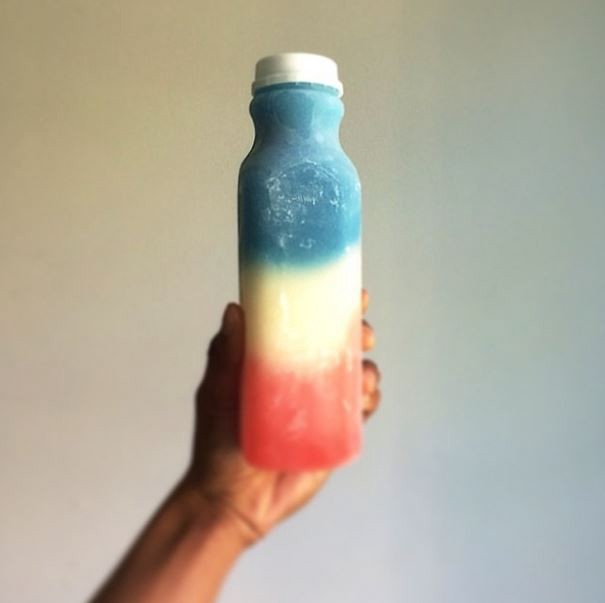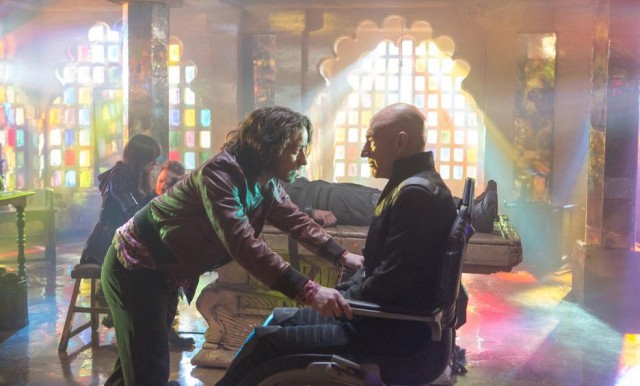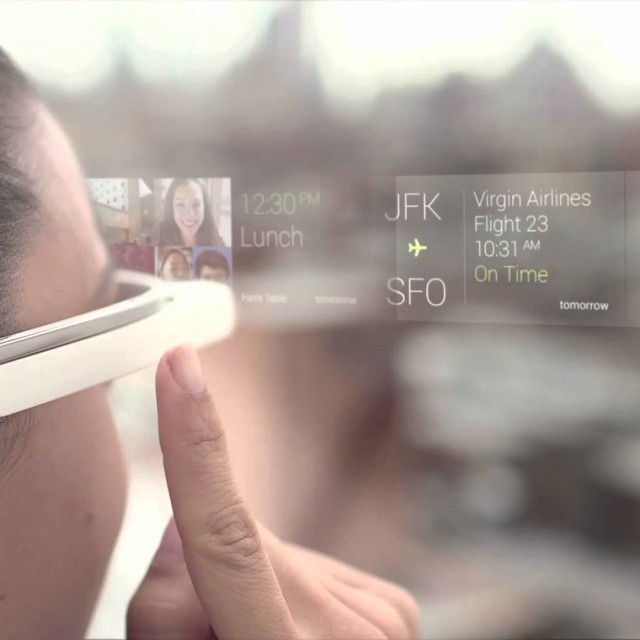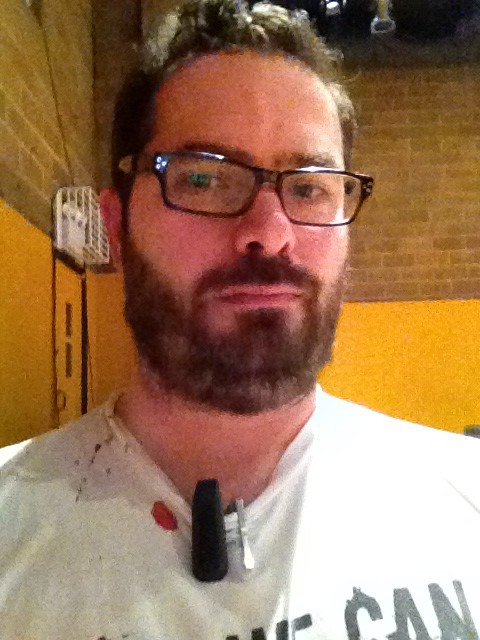Summer Trend Consecrated

Phrosties, the potent alco-slushies that New Yorkers in certain neighborhoods can order from an anonymous Instagram account, had nearly run their course. They had been covered by every outlet that might possibly have an interest in sweet icy rotgut. With thousands of followers, the drink had reached what seemed like a supply and attention plateau: Popular enough to earn a place in urban drunk legend, but small enough to remain proprietary. And then:
A company hawking a boozy Slushie over social media should have to prove it’s not selling to kids if it wants to stay in business, Sen. Charles Schumer said Monday. “A 12-year-old can probably buy these ‘sloshies’ online, get it and enjoy it because it’s filled with fruit juice and fruit punch and all the things that taste sweet and nice,” the New York Democrat said at a press conference.
Official Phrostie operations are now marked for death, which means that we are doomed to drink Phrosties for years. A senatorial call-out is how half-bogus drug and drink trends become real: Chuck Schumer has guaranteed the already non-trivial possibility that every young bar in New York City, and then in other cities, will formulate its own version. It promises Pinterest boards full of Phrostie imitations, perfectly layered and made with the finest liquors and syrups. Recipes, riffs on recipes. Theme parties. A mention on Girls. Eventually, a Diageo/InBev pre-packaged option. Summer has arrived. [Pic via]
A Borough, Filmed
“I would not consider it fair if someone in Williamsburg were complaining that we weren’t portraying Williamsburg in an accurate light, considering that person probably just moved here from Ohio,” said Nick Carr, another location scout. “Did they come here for the same reason they’re filming here” — in search of a gritty-yet-glamorous fantasy of Williamsburg?
The New York Times generously saved this piece — “To Hollywood, All Things Hip Lie in Brooklyn” — for your return to work today, since you’ll likely need all the fury you can muster to get through it. I mean have you seen the weather forecast, oof.
Comic Book Movies and the Forgotten Art of the Ending
by Ryan Britt

During the summer of 2008, as the credits scrolled past, and we sat giddily contemplating how much fun we’d just had watching Iron Man, Samuel L. Jackson sauntered out of the shadows to chat with Tony Stark about “the Avengers initiative.” This could have been a one-off appearance, but it was effectively the Big Bang of the Marvel Cinematic Universe, the umbrella franchise and shared setting for a small battalion of Marvel superheroes which now spans nearly a dozen movies and at least one television series over the last six years.
Initially, the big pay-off promised by the MCU — after two Iron Man movies, The Incredible Hulk, Thor and Captain America: The First Avenger — was 2012’s The Avengers, a mega team-up of several superheroes who had been relentlessly teasing audiences that they were headed toward the same cinematic party. Its tricky plot involved Thor’s adopted brother Loki conquering the world using the Tesseract — which, it turns out, is just one cothmponent of an even larger super-plot unfolding in this summer’s Marvel movies — while Nick Fury presciently assembled a team of heroes to stop him. It was a lot to process — Thor was practically required viewing, providing both The Avengers’ primary villain and MacGuffin — and only witty banter and a general message of “Go team!” made the film comprehensible for the average viewer, in stark contrast to what Marvel producer Kevin Feige had promised two years earlier: “We’ve always remained consistent saying that the movie that we are making comes first. All of the connective tissue, all of that stuff is fun and is going to be very important if you want it to be. If the fans want to look further and find connections, then they’re there.”
The result, more than six hundred million dollars in ticket sales for The Avengers, and billions for the MCU as a whole — conspicuous sums of money, even in the current blockbuster-and-sequel-studded financial vortex of Hollywood — has led other studios to the inexorable conclusion that they must construct Ur-franchises out of their own precious comic-book properties. Last summer’s Man of Steel, for instance, was the beginning of a DC Comics shared universe, disguised as a Superman reboot. The film was inundated with references to Wayne Enterprise, the fictional corporation owned and operated by Bruce Wayne, and though it didn’t feature a post-credits sequence with Ben Affleck as the new Batman, director Zack Snyder wasted little time announcing that the Superman sequel would be a full-on crossover. The title, officially announced this week, is even less subtle in announcing its intentions: Batman vs. Superman: Dawn of Justice is an obvious reference to the Justice League, which had been, until recently, the most resilient in superhero supergroup in our cultural supermemory. The latest Spider-Man movie, The Amazing Spider-Man 2, teased out the formation of a gang of franchise-ready bad guys — The Sinister Six, a kind of anti-Avengers — consisting of villains like Doctor Octopus, Vulture, Green Goblin, the Rhino, probably Mysterio, and maybe Black Cat. Meanwhile, X-Men: Days of Future Past, which aims to conjoin the two disparate X-Men franchises — Bryan Singer’s bland, stilted, modern-day heroes and Matthew Vaughn’s slick, sixties-cool X-babies — into a single storyline, does as much to reboot the franchise as unify it, allowing the uninterrupted production of further sequels.
Comic book movies, in other words, are becoming more and more like comic books themselves: serial adventures in which each installment leads to the next installment. Each movie gives you a fix of super-powered shenanigans, but doesn’t fully conclude much of anything at all, in the hopes you’ll be back for another dose. This logic works extremely well for comic books: Fans rarely cite the conclusion of a specific storyline as being necessarily all that satisfying. Many remember when Superman died in 1993’s Superman #75 and eventually came back to life, for instance, but nobody really cares how or why. It’s said that no one in science fiction stays dead; this is only truer in comic books, where it appears that no one can even catch a nap. But the nagging question here is: does this mode of storytelling work in the movies?
If you’re reading an issue of a comic book that ends in a cliffhanger or a teaser, and the next issue comes out in a couple of weeks, it’s a fairly natural and reasonable amount of time to wait until the next installment. Soap operas have been doing this for decades, and mainstream television has been managing this with (mixed) results recently. But the experience of film is inherently different than serialized comics, soap operas or television. The lights go up, and you walk outside and you go home or to a bar or to Applebee’s for half-off appetizers after 10 p.m. Films end. And while comic-book-style serialization might work in terms of perpetuating built-in audiences that generate unfathomable amounts of money, there is something inherently wearying about a series that never ends, filled with films that refuse to have an ending. In a movie with a storyline that resolves itself at the end — or at least artfully refuses to — you’re rarely left wondering if there will be a post-credits sequence, or one that will set up Inside Llewyn Davis 2: The Ghost of the Orange Cat.
A consequence of never-ending comic book movies is they’ve become more predictable than ever; they’re slavish to their source material to a fault. Last summer’s Iron Man 3 had Tony Stark seemingly retiring from the Iron Man business by finally having the shiny thing in his chest surgically removed, but nobody actually thinks Tony Stark has given up shooting over-the-top bad guys with photon blasters, otherwise there could be no sequel. Superman can’t die; Tony Stark can’t retire; Professor X can’t stay vaporized. If they did, the semi-sequels couldn’t be made. (At least, not without a reboot! R.I.P. Christian Bale’s sulky, blockheaded Batman.) It’s worth asking why we bother go to these films at all when we know precisely what will happen — even if the Joss Whedon-penned dialogue is slightly snappier than in the comic books and the spectacular feats seem slightly more spectacular on the screen than on the page.
Comic book movies, contra everything that is happening in Hollywood right now, could follow an alternate sequel path, like Superman in 1978. Because Mario Puzo and Richard Donner were more interested in making a good movie than adhering to the comic book continuity, they wound up producing a classic superhero movie or two. While General Zod promises that he will avenge himself onto Jor-El’s heirs at the beginning of Superman before making good on it in Superman II — which would probably make you think this trend of creating never-ending comic book movies is not new at all — the movies were planned and filmed (mostly) as a single story. Sure, we could imagine Superman having other adventures after it ended, but Superman II closed the loop. Superman III and Superman IV were awful precisely because they were produced by the same cynical kind of comic-book franchise exploitation we see today, with arbitrary villains, tedious, open-ended plots, and horrific acting. Christopher Nolan, Jonathan Nolan, and David S. Goyer, seemingly aware of this temptation, made their Dark Knight Trilogy a bizarre aberration: Shockingly, Batman retires in the final film, putting a period, or at least a semicolon, at its end. It felt earned, since it seemed like this story was small and contained enough to demand a specific ending, even though in the face of the multi-tentacled multi-film universe, the idea of a simple trilogy or even numbered sequels seems quaint.
This weekend, when Wolverine slides into the past in Days of the Future Past to correct some terrible deeds done in the seventies (besides the fashion, right? lol) in order to reshape the gross future from which he comes, it will mark a rare feat: a comic book movie being completely honest about how confusing it is, as the X-Men themselves run around rewriting their own history, undoing consequences, reversing deaths, and transforming endings into new beginnings. Of course, it will end the only way that it can: Wolverine will tragically succeed in making his world just like him, immortal and unending.
Ryan Britt has written for The New York Times, Tor.com, Clarkesworld, The Drum, Omni Reboot and elsewhere. He teaches at the Gotham Writers’ Workshop and lives in New York City. He is also on Twitter.
New York City, May 22, 2014

★ Wet patches darkened the bare concrete pillars of the new tower, and the street below was darkened completely. The rain was coming and going, so irregularly and in air so humid that it scarcely made a difference. Was the drip inside the B train condensation from the air conditioner or trapped rainwater? The soggy air grew chillier. At the end of the workday, a funk of damp bodies — sweat and grooming products — stuck to the lower platform at 59th Street. On the way to the upper, there was a glimpse of a wet shine on the steps leading out; umbrellas were in play. A brown mist covered the river. The sun came through for a moment, clear and precise, throwing the shadows of the blinds into the apartment, and then the clouds blurred it out and the rain resumed its falling or not falling.
Are Cyborg Identity Politics Destroying YOUR Favorite Restaurant?

Feast is a restaurant in New York that has been described to me as “cute” and “so-and-so’s favorite place.” It looks nice and people seem to like it. But Feast has made a mistake. EV Grieve has the story:
Toward the end of last month, Feast said that they had a customer arrive as a walk-in for brunch. She was wearing Google Glass. A few months previously, they had another diner wearing a pair and the restaurant received several comments about privacy from other guests. Restaurant staff asked the person to remove them, and he quickly consented.
So when the other diner came in wearing Google Glass, management asked her to take them off before dining. She refused, and left the restaurant.
This patron was angry enough to write about her experience online. She found an audience of like-minded Google Glass wearers to take umbrage, and now Feast’s rating on Google Maps has plummeted. This is not a small deal for a restaurant! Those Google ratings are the first thing people see when they search. It is also something that can be remedied and repaired, however, with a little effort on the restaurant’s part.
What’s genuinely alarming about this is what seems to be the emergence of… Google Glass identity politics? I think so! These are real posts:
-Unreal. Should have made everyone take their phones and put them in the car.
-Would have done the same also. Better to patronize those businesses that are “tech friendly”.
-The gall of some people does anger me at times though, I must admit. What makes these “other customers” feel that they are important enough for anyone to care to “record”?
-I can’t wait until wearable tech becomes the norm and establishments beg for folks to come back after they shuned them.
-We need a site that lists all Glass Friendly businesses and all anti-Glass businesses out there. Explorers can notify of a positive/negative experience to update. This would let us know where to spend our money when we travel.
-Everyone should give them a one star rating on Google Maps.
The reviews themselves:
-Ignorant bigots and hateful. Perhaps being illegally discriminate too. The food is irrelevant as the service is less than poor.
-Do not go here. They are very biased towards new technology. They allow patrons to use mobile phones to take photos or videos of other patrons. And they ask patrons to leave without fully understanding what a product does.”
It is the right of any person to attempt to wear Google Glass at a restaurant. It is also the right of any person to use the language of civil rights to describe their efforts to wear Google Glass at a restaurant.
Somewhere in here is a small and miserable business opportunity. The aggrieved patron, responding to supporters, describes a fascinating lifestyle:
[W]e take our business and money to places that clearly welcome Glass, like the Standard. Not really worth all that effort for a little restaurant like Feast.
Cash in while you still can!
And Now It's Something Else
And Now It’s Something Else
Sure, it was a “legendary local shoe store” and “now it’s a fucking fro-yo place,” but it probably won’t be for long:
Twist on Avenue A opened last fall, then promptly disappeared; the unrelated shop Twister on Second Avenue closed in March, lasting just over half a year. The festive-sounding Yogurt Crazy was first announced for Third Avenue in 2012 but instead, a notice from NYU — its landlord — appeared taped to the storefront last year demanding $37,134.87 in back rent. Over in Brooklyn, Forever Yogurt signed a lease near Barclays Center, but that ended in eviction papers and a claim of $12,000 in unpaid rent.
Independent shops aren’t suffering alone. Big Frogurt is having similar trouble: Pinkberry Chelsea, at Eighth Avenue, closed recently. Pinkberry Gramercy and Pinkberry Columbus Avenue were filled with customers this time last year, but have since gone dark. The chain’s once-mighty 177 Bleecker Street location, which had lines out the door, closed without any fanfare in 2012, three years after the Red Mango across the street had done the same.
In six months, it’ll be a “fucking juice place.”
A Drone Tried to Kill Me at a Gizmodo Party
by Matthew J.X. Malady
People drop things on the Internet and run all the time. So we have to ask. In this edition, Hausfrau magazine editor Stephen Kosloff tells us more about what it’s like to have a drone smack into your head and cut you up while you’re trying to play some foosball at a Gizmodo party.
I am now the only person I know who was wounded by a #drone at a @Gizmodo party. #tech pic.twitter.com/VdhiNS6RPX
— Stephen Kosloff (@stephenkosloff) May 22, 2014
Stephen! So what happened here?
I was celebrating closing an ad deal for my magazine, and by “celebrating,” I mean drinking alone, as usual. While walking from Bar A to Bar B, I stumbled on a Gizmodo party on Mulberry Street. I flashed my business card, said “Media,” and was admitted.
I was like, “Great, now I can get drunk before I continue drinking.”
This was a “House of the Future” party — a sexy sponsorship tie-in of some sort. It was a large auditorium with a number of faux “rooms” all kitted out with really excellent gear: TVs, kayaks, sofas, and one remote-controlled drone.
I tried on various protective headgear, helmets and such. Took some selfies (as one does).
Next, a few people gathered around the drone and fired it up! The drone shot up over the fake walls, and was lost to sight. It crashed somewhere in the distance. I thought to myself, “That could have injured someone,” but I didn’t speak up, a decision I attribute to my low self-esteem.

A couple of minutes later, a few folks had the drone on a table, and they fired it up again. It veered with the greatest violence into a nearby plant, shredded the shit out of its leaves, then crashed into a wall.
I was like, “Whatever,” and started playing foosball with a nice guy. Next thing I know, WHAM!!!!!!! Right in my fucking head. The drone.

It was mildly upsetting; not very painful, but a big shock. It knocked me pretty good. I knew right away that it was the drone because I’d seen it “acting out” earlier.
What happened next? Did you and everyone else there freak out? And, most importantly: Are you OK?
I went straight to the bathroom, using my Obama T-shirt to stanch the bleeding. I was concerned for a minute that I would need stitches, but I didn’t. The whole time, the editor of Gizmodo was there helping me out. He was mortified, and very helpful. I feel bad for him. He seemed to be freaked out.

The Gizmodo and event staff were very helpful and apologetic. They got me some band-aids and stuff to clean the cuts with. It got my right ear and two spots on my forehead.
After the party, I went to Bar B in my bloody t-shirt and continued getting drunk.
Lesson learned (if any)?
If you are attending a party that features both drones and helmets, and you put a helmet on to take a selfie, do not take the helmet off until you leave the party.
Just one more thing.
Drones make bad party toys.
Matthew J.X. Malady is a writer and editor in New York.
Music Recommendations Good
You click your way into an article called “63 Songs You Need In Your Life This Summer” thinking surely there can’t be 63 songs I need or even want this summer; in fact, I don’t need anything at all, certainly not from the internet, for I am strong and whole, etc. But Naomi Zeichner has built a good and world-spanning and deeply strange list of songs here, 63 of which You Might Enjoy Listening To Of Your Own Volition This Weekend.
New York City, May 21, 2014

★★ An overcast sky dimpled with blue straightened out into plain flat gray. The air was listless and humid, the day neither inviting nor forbidding. In the afternoon, the sun did not so much burn through as it negotiated an arrangement to cast a few shadows without dispelling the clouds. The jacket that had protected against the office air conditioning wasn’t necessary for the commute home, but to take it off would have been to grant the clammy atmosphere too much credit. The heavy twilight air sent rainbow sprinkles plopping from the soft-serve ice cream cone in clots, faster than the two-year-old could sprint on his way to take possession of it.
Here's What Young People Are Wearing in Bushwick
by Awl Sponsors
The Bushwick neighborhood in Brooklyn is equal parts industrial wasteland, emerging cultural center and flourishing arts scene for the young and creatively-inclined of New York. In the above feature, Times Video takes you to Bushwick’s Morgan Avenue stop on the L train, where dancer and actress Madison Krekel fits into the young, artsy crowd with sushi socks, dyed green hair and a Cramps T-shirt.
The video above is a part of Times Video’s “Intersection” series, which brings you from Brooklyn to Beijing, Portland to Paris — to capture the characters, looks and stories that are the hallmarks of a neighborhood’s style.
Find more immersive content at Times Video.
